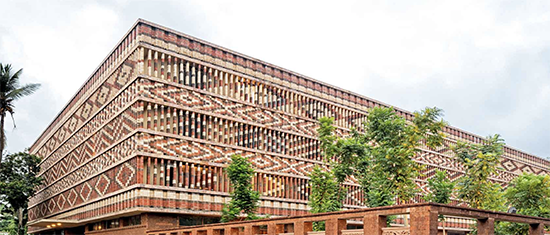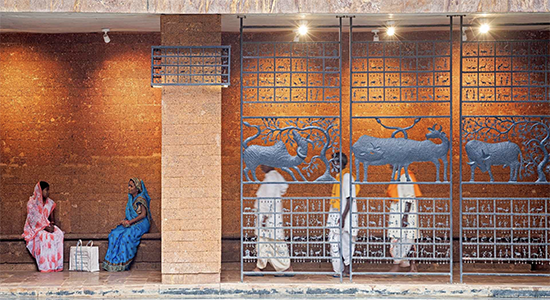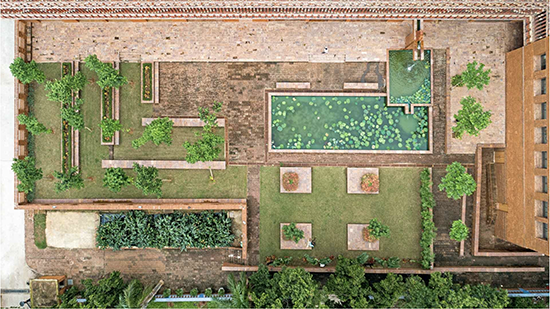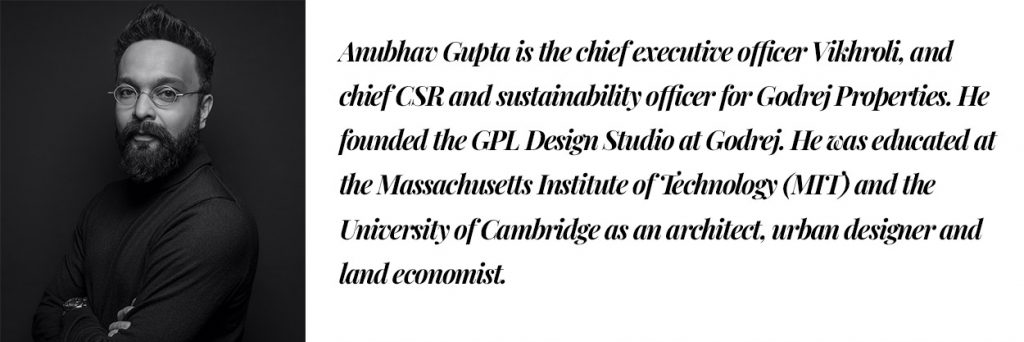Those Who Design series holds a critical lens to the contemporary architecture and design of our country. For the second episode of this series, we discuss with Ambrish Arora of Studio Lotus on reframing the brief to create a transformational impact. We also reflect on his integration of craft and local traditions in the building process to create what he calls a ‘patchwork of narratives’ bringing focus not only on the final outcome but also towards the positive energy infused in the joy of discovery and building of his work.
In much of his work, Ambrish begins his process by questioning the brief to reframe the mandate for his architecture to solve problems, ensure cultural and environmental sensitivity and infuse vibrant narratives especially during the building process and for the intended use of his buildings. He romantically reflects on local artisanal building, material and artform techniques which can lend architecture a unique ‘hand-made quality’. Whether building at the foothills of a fort in Jodhpur or on a hill in Kangra, his buildings are uniquely contextual, sometimes even designed and envisioned as ‘non buildings’ in case of the former so as to quietly serve their purpose yet make for a transformational leap by design.
Ambrish is however sceptical when it comes to the idea of Design in India for the word India which he believes singularly cannot represent one idea alone. Perhaps a purist from a regional vernacular perspective, he points out the irrelevance of a jharokha in Kerala and mischievously throws the question back at me — if I think the idea of Design in India is that of a polyester kurta or a khadi t-shirt? With no intent to make it political, either way his point is well made and therein lies the need for this conversation — what is our idea or non-idea for Design in India?
Here is an excerpt from the candid and honest conversation between Ambrish Arora and Anubhav Gupta
Designing and building Bhubaneswar’s iconic Krushi Bhawan
Bhubaneswar’s Krushi Bhawan is an institutional facility developed for the Government of Odisha’s Department of Agriculture & Farmers’ Empowerment. Designed by New Delhi based Studio Lotus, led by Ambrish Arora, Sidhartha Talwar, Ankur Choksi and Asha Sairam, the building spread over 2.1 acres of land and covering 1,30,000 sqft of area has delivered far more than the originally envisaged administrative space. The building provides working facilities for the state employees of the Department of Agriculture and includes 400 workstations, in addition to a learning centre, a library, an auditorium, training rooms, a garden and a landscaped plaza.
While the hard to miss ikat façade delivers on both its double skin environmental brief and the strong contextual iconography of Odisha; inside out, the building seems to be left wanting for a more thoughtful response in its useable interior spaces.
Discussing the particulars of the Krushi Bhawan project, Ambrish mentions they were privileged to have been selected amongst other architects on invitation by the Chief Minister of the State through a process outside the typical government tender route. Originally planned as a building for bureaucrats, Studio Lotus reframed the brief to include the engagement of farmers and the people of the city of Bhubaneshwar.

The big moves included opening the ground plane as an invitation to the public, building a case to move away from the aspirations of a modern glass façade in favour of environmental sensitivity and finding both the means as well as setting up mechanisms to integrate local craft within the building process. Ambrish talks about ‘building with care’, enjoying the process, finding embodied energy, and that connecting back to building in India where we have the skill, he believes to make a difference to create a larger ecosystem as key aspects of the project.
Ambrish is unequivocally accepting of my description of the building’s underwhelming response from an inside out perspective simply admitting that they ‘ran out of steam’.
What is also interesting here is the client-architect-builder-user connect or a thoughtful attempt to make one. Ambrish mentions that “the government is not one person,” and it takes much effort to bring a convincing argument to the forefront, let alone implement it through the process. The role of the builder has been celebrated with the architect’s stewardship of scores of crafts persons providing the building its signature iconography and handmade quality. While the hard to miss ikat façade delivers on both its double skin environmental brief and the strong contextual iconography of Odisha; inside out, the building seems to be left wanting for a more thoughtful response in its useable interior spaces.
In Krushi Bhawan, Studio Lotus and their patrons have managed to push the envelope far enough for the building to not only represent its brief, celebrate context and culture, be environmentally responsible in its function; but also serve as an example of the change for better Design in India especially in a government setting.
While one much appreciates the use of passive mechanisms for sustainability in architecture, the user jury is normally a mixed bag of varied responses on thermal, lighting and visual expectations from their workspaces. Ambrish is unequivocally accepting of my description of the building’s underwhelming response from an inside out perspective simply admitting that they ‘ran out of steam’. Studio Lotus’ commendable aspiration for pushing a vibrant ground floor program brief as well as to make for a roof offering productive landscapes have been tempered in realisation by the boring logistics of operating and running such spaces especially in a government building — something our country needs to catch up on even in the private sector.



When asked to put himself in the shoes of a critic Ambrish is disarming with his humility and response to some of his own questions:
- Were we over ambitious in what we imagined it would be like? Yes.
- Did we foresee the ultimate operational lacuna? No.
- Did we have the wisdom and foresight to envisage these things would happen? No.
- Does the program support its mandate beyond the tourism and farmers? No.
Despite his own critique, high expectations and a sobering temperance on some aspects of the project, Ambrish retains his optimism for pushing the envelope and furthering the transformational impact for Design, and in India, however he possibly can. This is special and noteworthy. In Krushi Bhawan, Studio Lotus and their patrons have managed to push the envelope far enough for the building to not only represent its brief, celebrate context and culture, be environmentally responsible in its function; but also serve as an example of the change for better Design in India especially in a government setting. This project may even have prototyped processes such as tenders for craft-based construction practices. Each unrealised aspiration here is an opportunity for success with the hope that the next project will be even better and more impactful. These are not mistakes or miscalculations, rather the iterations that are needed to kick our design quotient and expectations from it, up a notch. It takes a tribe to make design work — investors, clients, architects, builders, craftspeople, artists, operators and users. It is not the designer’s responsibility alone so the critique must also be a shared one.
***

Feature image: Sameer Kulavoor, INFRASTRUCTURE 1, 2020 Solid Marker on paper, 5 x 7 inches each, Set of 10, courtesy of Sameer Kulavoor and TARQ, copyright Sameer Kulavoor, 2020


